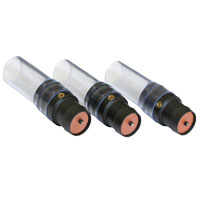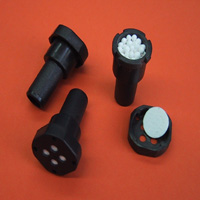

How do drone valves work?
by Ian Lyons
Despite what most pipers believe, devices that regulate airflow have been used in bagpipes for well over 200 years.
They are widely dismissed by many experienced pipers as an easy-fix or a detriment to the quality of the bagpipes overall sound, but actually that couldn't be further from fact.
Hopefully we can shed some light on what drone valves actually do and why they can be a great tool to create and sustain a steady and consistent sound.
History
There is evidence of a type of airflow regulator that was used in bagpipes over 200 years ago to assist with starts and stops and to alter the airflow to the drone reeds. When turning the stocks of the bagpipes, bagpipe makers, using the same piece of wood, would turn what looked liked a champagne cork shaped device, that would be inserted into the bottom of each of the three drone stocks. This device would have a small hole drilled right through it to compress, and therefore regulate, the air velocity, capacity and volume being allowed to travel from the bag to the drone reeds.
These devices were installed into the bottom of the drone stocks before the stocks were tied-in to an animal skin pipe bag.
Airflow
Drone valves and airflow regulators are attached to the bottom of the drone stocks or within a moisture control system inside the bagpipe bag. The immediate effect of all drone valves, tone enhancers, air regulators and even moisture control systems is that they will alter airflow. Before any of these devices are fitted, we essentially have an open pipe bag with air flowing directly into the stocks and towards the reeds. The airflow is not regulated or changed in any way. This can make it difficult for many pipers to maintain a steady and concise sound and can also make it unreliable for you to effectively start and stop your bagpipes.
By inserting any of these devices, you immediately change the air flow to the reeds by reducing the bore size of the stock. This creates a sort-of backstop against the device and then the air flowing through becomes more compressed which actually in turn makes it more precise, steadier and more direct.
Contrary to belief and knowledge about how drone reeds work, a slightly reduced airflow to a drone reed can produce a more mellow and smoother tone. Overall drone sound is not just determined by volume alone! It is a conbination of volume, steadiness, richness, smoothness, mellowness and the overall balance between the bass and tenor drones and the pipe chanter.
Below is a photo of a set of Hylands Inline Drone Valves (left) and a set of Shepherd Tone Enhancers (right)


Drone Valve Flap
The valve flap component of many drone valve devices is seperate, but also works in conjunction, to airflow regulation. The valve flap works very simply. When the bagpipe bag is struck to start the drones, the valve flap opens. The valve flap continually remains in the open position whilst the bagpipes are sounding. It essentially doesn't do anything else whilst your bagpipes are playing.
When you decides to stop, you squeeze the bag down to a certain point and then release your arm from the bag. At this time the valve flaps will all close and assist in stopping the drone reeds from sounding. Therefore, eliminating that terrible trailing-drones sound that all pipers hate and dread!
The drone valve flap can also be slightly tightened or loosened to change the airflow to the drone reed. By adjusting the drone valve flap, you can change where the flap sits in the open position and how much pressure is being required to hold it there.
The drone valve flap is what attracts many pipers to installing these devices. It can be frustrating and difficult for learners, young children and older pipers who don't have the physical strength to perform the starts and stops with good effect. For learners, older pipers and young children these devices can offer a more enjoyable experience with their piping. It is important to use the devices sensibly whilst still developing the skills required to perform these tasks effectively as you proceed in the learning stages.
Why regulate the airflow?
Regulating the airflow to the reeds gives you options to manipulate the way in which the air travels to the reeds and how that can enhance your performance. Much like fuel injectors in car engines which allow the precise amount of fuel to enter the chamber to produce as effecient running and reliability as possible.
By using these devices you can determine the precise airflow, capacity, volume and pressure that is travelling to each reed and therefore creating a steadier and more consistent sound.
Drone valves set up incorrectly
This is where there is a lot of conjecture around the use of drone valves, tone enhancers and similar devices.
It is imperative to producing a reliable and consistent sound that your devices are set up correctly to enhance your bagpipe sound. Not to inhibit the reeds from producing a quality sound. It is very easy to get carried away with these devices ability to help you start and stop your pipes and in turn forget about the quality of your bagpipe sound.
Before you install any device in your bagpipes, test what they are actually doing! Play your drones with and without them for comparison. It is possible to make the neccesary adjustments to make sure the effect they are having on your overall sound is a positive one, with the addition of the assistance in starting and stopping and airflow regulation that the device can offer.
These devices will only "assist" you, they won't actually do it for you. You still have to develop the skills to be able to perform these tasks to a good degree of efficiency.
Over tightening drone valves will almost certainly help you to start and stop the drones easier but they also have the capacity to significantly reduce the quality of sound being produced by your bagpipes!
Any Questions:- sales@lyonsbagpipes.com
Website Created and Managed by Lyons Bagpipes & Highland Supplies©